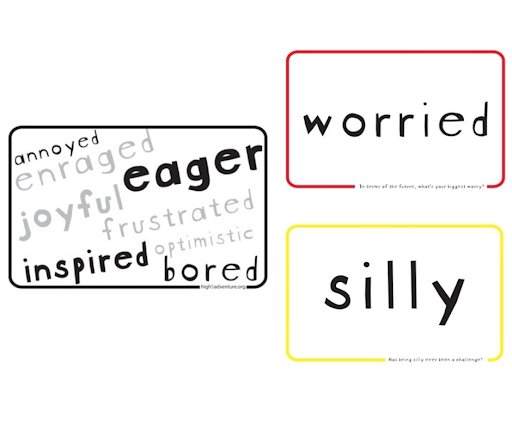Developing an Emotional Vocabulary
A Resource to Help Navigate Your Emotions

Let’s Talk About Emotions
It’s powerful stuff, the connection between emotions and learning. The sheer number of emotions we experience daily, down to the minute, can be mind-boggling. As experiential educators, we think about emotions often, and how they impact learning in the classroom, on the challenge course, and even in our work experience. One question we turn to again and again, when talking about emotions with others is…

Inevitably, hands around the room quietly raise in agreement.
Navigating and understanding how emotions impact our lives and learning is complicated. Developing an emotional vocabulary is an important part of the learning process and one that can be taken for granted. Imagine this… Being tongue-tied, especially when you’re mad, sad, or glad and you just can’t find that word that says exactly how you feel.
Or, remember that feeling when your fists clenched, or your stomach knotted, or your breath came short and your heartbeat quickened? Maybe not. You probably wouldn’t unless someone reminded you of the situation. Want to know why? Because remembering is like learning in that both are affected by emotions. Emotions can make it easier or harder, and make a difference in how we learn and retain information. To explore this further, let’s briefly focus on the amygdala—the gatekeeper of our memories.
The Influence of the Amygdala

Who can relate to this scenario? You are in a meeting, or in class, and gradually stop listening and begin daydreaming about the end of the meeting. Suddenly you are shaken into joining the conversation by your boss, or your teacher, who’s asked you a question. Your colleagues, or classmates, are staring you down, and your supervisor, or teacher, is waiting for an answer. An internal voice says “Read the room” and your brain goes into overdrive. Who’s supportive? Who’s hostile? Who thinks it’s funny you got caught zoning out? What are the threat factors? Why are you feeling flush? And under all those questions, what part of your brain is making these evaluations and what are they based on?
Welcome to your amygdala, the part of the brain that can be impulsive and at the same time the brain’s emotional center functioning as a gatekeeper to your acquired memories. It’s often referred to as the part of the brain that activates a fight-or-flight response. Much has been written about the physical influences, including emotions, that affect our brain’s ability to learn and form long-term memories. The amygdala’s role as the initial gatekeeper is to assess which of our experiences should be considered essential, e.g., those considered to be an immediate recognition of threats to our wellbeing.
Physical threats are not the only ‘influencers’ of our ability to learn and form memories. Emotions play an important and more nuanced role in that process too, both aiding and impeding our ability to learn and shape lasting memories of what we experience and then condition our responses to future stimuli. Classroom teachers and facilitators can use emotional intelligence to help create a learning environment that fosters positive emotions, increasing the brain’s ability to learn and remember. But first, we need a common language to identify and begin to understand our emotions– in short, we have to be able to name them. How do we acquire the language to know how to think about what we are feeling and thinking and gain the social intelligence and literacy we need to understand ourselves and others?
Exploring Emotions in a Safe Environment
Whether in middle school or middle age, language gives us the power to identify and name what is happening inside and around us and to understand its impact on how we see our own and others’ actions. The language of emotions can be learned and shared, sometimes directly, through social interaction, and sometimes indirectly, through stories, cooperative learning, and collaborative project-based activities.
As experiential educators, we value and utilize less structured learning settings that are free from assessments and competition to create safe learning environments and encourage group participation. We consistently observe that adventure-based experiential activities foster a sense of safety and positivity, promoting receptive emotional responses to academic lessons or other performance-based discussions. Engaging in activities that involve lively social interactions, collaborative physical problem-solving, and inclusive communication for exploring and evaluating ideas helps shape these enriching and positive learning opportunities.


Thinking About Thinking
From a learning perspective, whatever grade, academic subject, or group of participants, our Emotions by High 5® cards support educators and facilitators in creating emotionally positive learning environments. Check them out in our Store, and think about the possibilities for use with your groups.
But first, let’s acquire a shared language, a way to name our emotions and through that simple act begin to own and take control of them and ourselves. Emotions by High 5® cards allow individuals to identify the emotions and feelings they are experiencing, naming and owning them and beginning to explore their impact on our own and others’ thinking and behavior, as well as the real challenge of controlling them. As we said, the amygdala opens the gate to learning, but what you know determines where you go from there.
Additional Reference Materials
- The brain, emotions and learning – THE EDUCATION HUB
- Impact of Emotions on Learning (linkedin.com)
- “The Brain and Fear” – Adventure Park Insider, Chris Ortiz
- Learn more about Emotions by High 5® cards